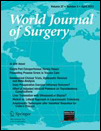Comparing Outcomes Between Side-to-Side Anastomosis and Other Anastomotic Configurations After Intestinal Resection for Patients with Crohn’s Disease: A Meta-Analysis
Abstract
Background
Anastomotic configurations may be a predictor of postoperative recurrence for Crohn’s disease. One previous meta-analysis showed side-to-side anastomosis was associated with fewer anastomotic leaks but did not reduce postoperative recurrence rates. After 2007, more articles that found distinct results were published. We aimed to update the meta-analysis comparing outcomes between side-to-side anastomosis and other anastomotic configurations after intestinal resection for patients with Crohn’s disease.
Methods
A literature search that included PubMed, EMBASE, the Science Citation Index, and the Cochrane Library was conducted to identify studies up to May 2012. Trials comparing side-to-side anastomosis with other anastomotic configurations for Crohn’s disease were analyzed. Sensitivity analysis and heterogeneity assessment were also performed.
Results
Eleven trials compared side-to-side with other anastomotic configurations were included. Overall, results showed a significant reduction in the overall postoperative complications [n = 777; odds ratio (OR) = 0.60; P = 0.01], but side-to-side anastomosis did not reduce the anastomotic leak rate (n = 879; OR = 0.48; P = 0.07), complications other than anastomotic leak (n = 777; OR = 0.72; P = 0.13), endoscopic recurrence rates [hazard ratio (HR) = 0.73; P = 0.07], symptomatic recurrence rates (HR = 0.74; P = 0.20), and reoperation rates for recurrence (HR = 0.37; P = 0.06). Sensitivity analysis including two randomized controlled trials found no significant differences in short-term complications between the two groups. Sensitivity analysis including nine trials comparing only stapled side-to-side anastomosis with other anastomotic configurations showed stapled side-to-side anastomosis could reduce reoperation rates (HR = 0.38; P = 0.01).
Conclusions
Side-to-side anastomosis did not reduce short-term complications and postoperative recurrence for Crohn’s disease. Stapled side-to-side anastomosis may lead to fewer reoperations needed for recurrence. Further randomized, controlled trials should be conducted for confirmation of recurrent events.




